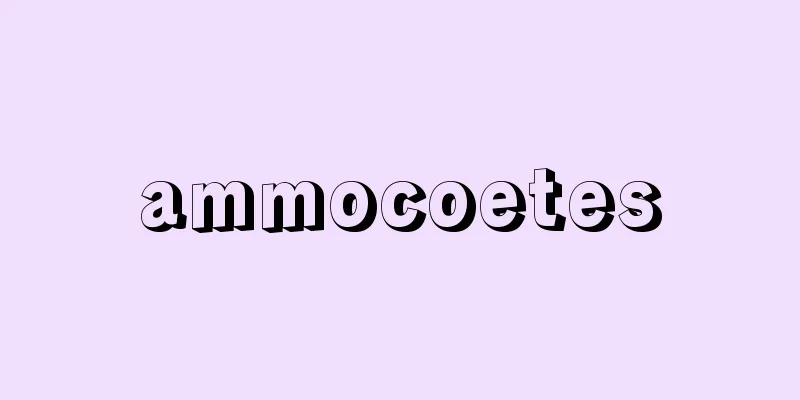Fushikaden - Fushikaden

|
This is a treatise on Noh by Zeami, the master of Noh, and is one of Japan's leading art treatises. Three volumes were compiled in 1400 (Oei 7), and it was written based on the teachings of his father Kan'ami. It is a secret teaching written to convey the essence of Noh to a single true successor, but it has immortal value as a general theory on theater, art, education, life, and aesthetics of charm. Zeami himself said that the title of the book was "called Fushi Kaden," and when abbreviated, it is "Kaden," so it is incorrect to use the colloquial name "Kadensho." "Kadensho" refers to the entire collection of Noh teachings from the late Muromachi period and the teachings of Tachibana, and was the name used by Yoshida Togo when he first reprinted it in 1909 (Meiji 42). It was also the proper noun of the late Muromachi period Noh instruction book "Kadensho (Eight volumes)." It is composed of seven stages. First, there is the "Jo" (Introduction), which explains the mindset of a Noh actor. The "First Article on Annual Training," which is a curriculum by age, recommends that training should begin at age 7, and is divided into seven stages, including how to overcome the slump at age 17 or 18, things to be careful of when debuting, the age when you are in your prime, and strategies for withdrawing from the age of 40 and above. The "Second Article on Impersonation" is a theory of acting by genre (mainly on dress-up), following the general theory of acting, and is divided into nine categories: women, old people, face-to-face actors, madmen, priests, asuras, gods, demons, and Chinese characters. The "Third Article on Questions and Answers" is thought of as Kan'ami's answers to Zeami's questions, and includes theories on directing, the rank of the art, and the aesthetics of Noh. The Fourth Shinginiwaku is different in content and style, and describes the origins, history, and legends of Noh that have been passed down in the troupe. There is a theory that Hatano Kawakatsu, the founder of Noh, was the reincarnation of the First Emperor of Qin, but it is a valuable work in understanding the traditional consciousness of Noh actors. The second part has a different "Preface", and in "Okugi-un" (The Secret Art), Zeami explains the differences in style between Yamato Sarugaku, the style to which he belonged, and Omi Sarugaku or Dengaku, but argues that because audience tastes vary, there should be a broad range that allows any art to be performed. Appealing to all audiences was what Kan'ami advocated. "Sixth: Kashu-un" (The Flower Practice) is a theory on Noh, acting, audiences, and a comparison of performers. "Seventh: Separate Oral Transmission" (The Attached Paper) explains the aesthetic of charm, "flowers," which was the goal he pursued, and clearly explains why he likened it to a flower, stating that flowers are interesting, and that this is nothing other than their rarity. The essence of performing arts, which can only exist in a relative relationship with the audience, is discussed, as well as theories on imitation, the tricks for achieving infinite changes through the ten bodies and the flowers that come and go every year, the truth behind the saying ``The secret is the flower,'' and the theory of ``the thrilling time for a man.'' "Fushikaden" is Zeami's first theoretical book, written when he was around 40 years old, and is also considered to be his intention to break away from Kan'ami's theories. Zeami himself said that "Kakyo," written in his 60s, was his theory from after that, but it can be said that the outline of Zeami's later theory on Noh is in "Fushikaden." [Masuda Shozo] "Fushikaden" (Iwanami Bunko)" ▽ "Zeami 16-part Collection by Nose Tomotsugu (1940, Iwanami Shoten)" ▽ "Japanese Classical Literature Series 65: Collection of Poetry and Nohgaku Essays" (annotated by Nishio Minoru et al., 1961, Iwanami Shoten)" ▽ "Japanese Classical Literature Collection 51: Renga Essays, Nohgaku Essays, Haiku Essays" (annotated by Omote Akira et al., 1973, Shogakukan)" ▽ "Japanese Thought Series 24: Zeami and Zenchiku" (annotated by Omote Akira and Kato Shuichi, 1974, Iwanami Shoten)" ▽ "Shincho Japanese Classical Collection: Collection of Essays on Zeami's Art" (annotated by Tanaka Yutaka, 1976, Shinchosha)" ▽ "Reading the Classics 17: Fushikaden" (1984, Iwanami Shoten) by Baba Akiko [Reference] |Source: Shogakukan Encyclopedia Nipponica About Encyclopedia Nipponica Information | Legend |
|
能の大成者世阿弥(ぜあみ)の能楽論で、日本を代表する芸術論。1400年(応永7)に三編までがまとめられ、父観阿弥(かんあみ)の教えに基づいて著したものである。ただ1人の真実の後継者に能の真髄を伝えようとして書かれた秘伝であるが、汎(はん)演劇論として、芸術論として、教育論、人生論、魅力の美学として、不滅の価値をもつ。書名については世阿弥自身「風姿花伝と名づく」といっており、略する場合は「花伝」であるから、「花伝書」という俗称を用いるのは正しくない。「花伝書」は、室町後期からの能の伝書の全体、そして立花の教えをさすことばであり、1909年(明治42)に吉田東伍(とうご)が初めて翻刻するときに用いた名称であり、また室町末期の能の指導書『(八帖(はちじょう)本)花伝書』の固有名詞であった。 構成は七段である。まず能の役者の心構えを説く「序」。年齢別カリキュラムである「第一年来稽古(ねんらいけいこ)条々」では、7歳から稽古を始めよと説き、17、8歳のスランプの時期の乗り切り方、デビューのころの注意から、花の盛りの年代、40歳以降の撤退作戦など、七期に分けられている。「第二物学(ものまね)条々」は、演技総論に続くジャンル別の演技論(扮装(ふんそう)論が主軸)であり、女、老人、直面(ひためん)、物狂(ものぐるい)、法師、修羅(しゅら)、神、鬼、唐事(からごと)の9分類となっている。「第三問答条々」は、世阿弥の質問に観阿弥が答えた形とも考えられ、演出論、芸位論、能の美学論などを内容とする。「第四神儀云(しんぎにいわく)」は、内容も文体も違っており、座に伝わる能の発生、歴史、伝説が書かれている。能の始祖の秦河勝(はたのかわかつ)を、秦(しん)の始皇帝の生まれ変わりとするなどの説も語られるが、能の役者の伝承意識を知るうえで貴重である。 後編は、別の「序」をもち、「奥儀云」は、世阿弥の属した大和申楽(やまとさるがく)と、近江(おうみ)申楽、あるいは田楽(でんがく)との芸風の違いを説くが、観客の好みはまちまちだから、どの芸でも演じうる幅広さをもつべきだとする。あらゆる観客層へのアピールこそ、観阿弥の主張であった。「第六花修(かしゅう)云」は、能作論であり、演技論であり、観客論であり、演技者の比較論である。「第七別紙口伝(くでん)」は、目標として追求してきた魅力の美学「花」の解明であり、なぜ植物の花に例えたのか、花は面白(おもしろ)さであり、それは珍しさにほかならないと、明快な論が展開される。観客との相対関係のなかでしか成立することのない舞台芸術の本質が語られ、物真似(ものまね)論、十体と年々去来の花による無限の変化を実現するくふう、「秘すれば花」の真実、「男時女時(おどきめどき)」の理論が語られる。 この『風姿花伝』は世阿弥40歳前後からの、彼の初の理論書であるが、観阿弥理論からの脱皮の意図ともされる。60歳代の『花鏡(かきょう)』はそれ以後の理論と世阿弥自身述べているが、世阿弥後年の能楽論の大綱はこの『風姿花伝』にあるといってよい。 [増田正造] 『『風姿花伝』(岩波文庫)』▽『能勢朝次著『世阿弥十六部集』(1940・岩波書店)』▽『西尾実他校注『日本古典文学大系65 歌論集 能楽論集』(1961・岩波書店)』▽『表章他校注『日本古典文学全集51 連歌論集 能楽論集 俳論集』(1973・小学館)』▽『表章・加藤周一校注『日本思想大系24 世阿弥 禅竹』(1974・岩波書店)』▽『田中裕校注『新潮日本古典集成 世阿弥芸術論集』(1976・新潮社)』▽『馬場あき子著『古典を読む17 風姿花伝』(1984・岩波書店)』 [参照項目] |出典 小学館 日本大百科全書(ニッポニカ)日本大百科全書(ニッポニカ)について 情報 | 凡例 |
Recommend
Ibrahim Roadie - Ibrahim Roadie
...While the other dynasties were of Turkish orig...
Quenching oil - Yakiireyu (English spelling)
Mineral oil for heat treatment such as quenching a...
Addition circuit - Addition circuit
Also called an adder. A circuit in a computer that...
Cypris
…The nauplius has an inverted triangular carapace...
Odawara stories
…It is also called Odawara Dango or Odawara Banas...
Spinning wheel - Itokuriguruma
〘 noun 〙 A wheel used to separate thread from coco...
Anklet
...An accessory worn around the foot in a ring sh...
Decapitation - Kirikubi
1. To cut off a head. Also, a severed head. Head-c...
"Enshu Relics Book" - Enshu Relics Book
...This is the common name for the register that ...
Matshoba, M.
...The same can be said of writers such as Peter ...
Jisho-Juei Civil War
A nationwide civil war that took place from 1180 (...
measure of economic welfare
…Furthermore, investments included in national in...
Selection of Manners and Customs - Selection of Manners and Customs
A collection of haiku poems from the mid-Edo perio...
accelerated freeze-drying
…Freeze-dried meat was researched and developed i...
School Library Council - School Library Council
...However, the number of librarians in school is...









![Oharu [town] - Oharu](/upload/images/67cb17e27816b.webp)